#Promoting sustainable shipping practices
Text
Becoming sustainable is a journey that takes a long time. You can not and will not change your lifestyle to fully sustainable in a month. Changing your entire lifestyle in a way that directly clashes with how society is currently functioning (consumerism/capitalism) is not as easy as the tiktokers doing partnerships with bamboo toothbrushes make you believe.
Start small. Repurpose things you already have, even if they aren’t recyclable. Scrape the last of your moisturizer into a tub if it won’t come out the bottle any more. Use the cut open bottle as a pin holder. Use old dvd cases as letter storage, for arts and crafts, to protect your post. Donate things you can’t reuse to your local charity shops or shelters.
You’re also inherently going to have to learn new skills. Learning to stitch clothing to repair clothes, and learning how to sew to re-use clothes that can’t be salvaged. Learning some basic carpentry and upholstery skills for furniture, learning how to compost properly, learning to cook in unusual ways like canning and bulk cooking, gardening and farming. You’ll need to learn how to navigate shopping sustainably by researching the brands you consume, the shops you buy at, the local economy.
There's also the emotional toll of it. Learning new skills and leading a sustainable lifestyle will be very rewarding and fulfilling, but the journey there will be difficult. Researching it all will likely depress you, you’ll come across how shit nestle is, how deep-rooted consumerism is, how it impacts the ocean and humanity. You’ll find there's almost nothing, no brand, no item, no store that hasn’t been touched by consumerism and problematic practices, and it will get absolutely exhausting. You’ll find YouTubers and bloggers who have been doing this longer than you and finally help you navigate everything, and then they’re a terf. It’s going to be a challenging journey.
You will also realize becoming fully 100% sustainable is impossible to you and gated to rich people. You will need to accept this. Not everyone has access to local shops that provide sustainable items, and online shipping itself is usually not eco-friendly. Having a pet might be a roadblock, unless you can build your own house it's probably not built sustainably, if you live with family or roommates they might dampen your lifestyle. You’ll learn that being sustainable isn’t going the whole solution to saving the planet. You cannot strive for perfection here, you can only make an effort.
But making the effort is the point. Living sustainably makes you part of a positive cycle that supports local businesses, promotes a healthier and more fulfilling life, helps your local ecosystem and community. That makes the effort worth it.
191 notes
·
View notes
Text
Tides of Change Addressing Global Garbage on Alaska's Beaches
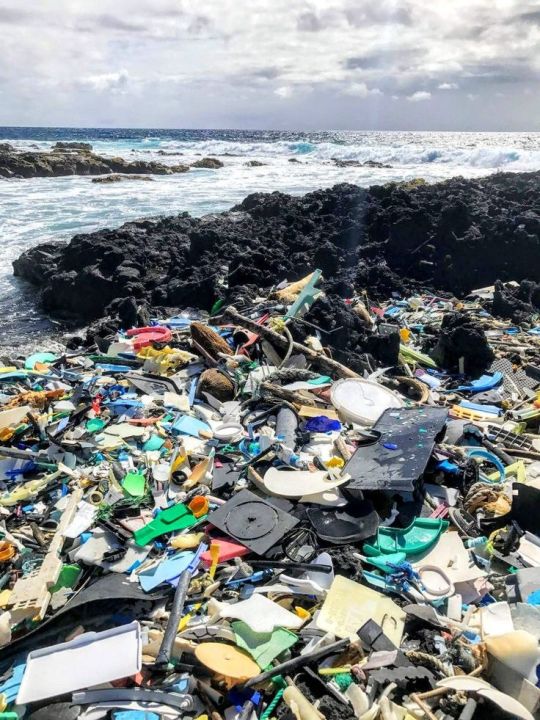
Alaska's pristine coastline, often celebrated for its rugged beauty and untamed wilderness, faces a growing threat: an influx of garbage from around the globe. Despite its remote location, Alaska's beaches are not immune to the pervasive problem of marine debris, with trash washing ashore from distant shores. From plastic bottles to fishing gear, this garbage poses a significant environmental hazard, endangering wildlife and spoiling the natural beauty of these coastal landscapes.
While Alaska's beaches may seem isolated, they serve as a final destination for marine debris carried by ocean currents from far-flung regions. Discarded items from coastal communities, commercial fishing vessels, and even overseas shipping contribute to the mounting problem of garbage washing up on Alaska's shores. Once ashore, this debris can persist for years, polluting habitats, entangling marine life, and leaching harmful chemicals into the environment.
The impact of marine debris on Alaska's coastal ecosystems is profound. Wildlife, including seabirds, marine mammals, and fish, often mistake plastic fragments for food, leading to ingestion and starvation. Entanglement in discarded fishing nets and lines can prove fatal for marine animals, hindering their ability to feed, swim, and reproduce. Moreover, the accumulation of garbage diminishes the aesthetic value of Alaska's beaches, tarnishing their allure for residents and visitors alike.
Addressing the issue of global garbage on Alaska's beaches requires a concerted effort at local, national, and international levels. Coastal communities must implement waste management strategies to reduce the amount of trash entering marine environments, including recycling programs, beach cleanups, and public education campaigns. Collaboration between government agencies, non-profit organizations, and industry stakeholders is essential to coordinate cleanup efforts and promote sustainable practices.
Furthermore, international cooperation is vital to address the root causes of marine debris, including plastic pollution and improper waste disposal. Multilateral agreements, such as the Basel Convention and the International Maritime Organization's MARPOL Annex V, aim to regulate the transboundary movement of hazardous waste and prevent marine pollution. By strengthening these agreements and enforcing regulations, the global community can mitigate the impacts of marine debris on Alaska's beaches and beyond.
In conclusion, Alaska's beaches are not immune to the scourge of marine debris, with garbage from around the world washing ashore on its pristine shores. The proliferation of plastic pollution, discarded fishing gear, and other waste poses a significant threat to coastal ecosystems and wildlife. Addressing this issue requires collective action at the local, national, and international levels, including waste management initiatives, cleanup efforts, and international cooperation. Only through concerted efforts can we protect Alaska's beaches and preserve their natural beauty for future generations to enjoy.
2 notes
·
View notes
Text
Pula wins world’s first Friend of the Sea Sustainable City Award
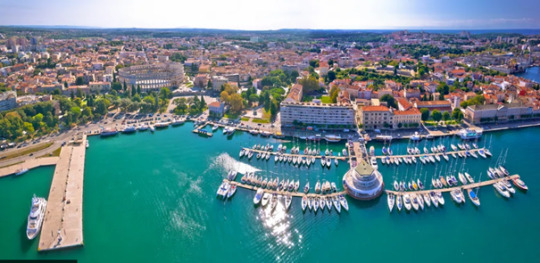
The efforts and initiatives of the Croatian city of Pula to preserve its marine environment and species have been recognised by Friend of the Sea[1], a project of the World Sustainability Organisation (WSO)[2]. Pula has become the world’s first winner of the Friend of the Sea Sustainable City Award[3], which aims to promote sustainable practices and the protection of marine ecosystems.
The award handed by the Friend of the Sea project praises Pula’s efforts to preserve the environment and improve its citizens’ quality of life by embracing sustainable solutions, according to a press release from the WSO.
“We recognize the city of Pula’s impressive record in adopting sustainable practices and marine conservation initiatives. For this reason, we decided to award it with the Friend of the Sea placard”, said Paolo Bray, founder and director of the WSO, which promotes sustainable practices through its two main certification programs – Friend of the Sea and Friend of the Earth
Pula is also among the 100 most sustainable destinations in the world, which demonstrates its ability to work with all stakeholders, particularly environmentally conscious companies, individuals, and associations committed to adopting sustainability, according to the statement.
The sustainability initiatives that Pula has implemented so far include establishing and improving a waste management system, implementing a green model of storm water drainage, and introducing eco-buses that use compressed natural gas, as well as electric bicycles and electric scooters in its public transportation system. It also plans to co-finance the purchase of energy-saving devices and the installation of solar panels.
In June this year, the Pula Aquarium received the Sustainable Aquarium certification from Friend of the Sea for its contribution to promoting environmental policies and animal welfare. At the award ceremony, a sea turtle rehabilitated in the Aquarium’s Rescue Center was released into the sea.
The turtle was released at Pula’s Ambrela Beach, which is in final stages of the certification process to receive the Friend of the Sea Sustainable Beaches[4] label, the WSO said in the statement, adding that the requirements include the absence of disposable plastic, water quality, and respect for the natural ecosystem.
In addition to the already implemented activities, the city of Pula plans to introduce other environmentally friendly measures such as co-financing the purchase of energy-saving devices and the installation of solar panels.
Source
Pula wins world’s first Friend of the Sea Sustainable City Award, in: Balkan Green Energy News, 13-10-2022, https://balkangreenenergynews.com/pula-wins-worlds-first-friend-of-the-sea-sustainable-city-award/
[1] Friend of the Sea is currently a project of the World Sustainability Organization, an international NGO whose mission is to promote environmental conservation. Friend of the Sea has become the leading certification standard for products and services which respect and protect the marine environment. The certification awards sustainable practices in Fisheries, Aquaculture, Fishmeal and Omega 3 Fish Oil. Friend of the Sea also promotes pilot projects related to restaurants, sustainable shipping, whale and dolphin-watching, aquaria, ornamental fish, UV creams and others. https://friendofthesea.org/friend-of-the-sea/
[2] WSO is the only organization proposing two consumer friendly logos which can potentially certify sustainability for the whole food range (seafood and agro) as well as non-food products and services. WSO delivers the certifications based on 30 years’ experience in the field, in full independence and by mean of audits of accredited certification bodies. https://www.wsogroup.org/
[3] https://friendofthesea.org/the-city-of-pula-receives-the-first-friend-of-the-sea-sustainable-award-for-its-merits-in-showcasing-sustainability-and-environmental-awareness/
[4] https://friendofthesea.org/sustainable-standards-and-certifications/sustainable-beach/
20 notes
·
View notes
Text
Cali Bud Strain
Introducing California Weed: Unleashing the Power of Cali Bud Strains.
When it comes to enjoying the finest cannabis strains, California is undoubtedly a pioneer in the game. With its ideal climate and expert cultivators, the Golden State has become synonymous with top-notch bud. At California Weed, we are proud to bring you an exclusive collection of Cali Bud Strains that will take your cannabis experience to new heights.
Cali Bud Strain: A Taste of California's Finest
When you think of California, you might picture stunning beaches, palm trees, and a laid-back lifestyle. But what truly sets California apart is its flourishing cannabis industry. With a rich history deeply rooted in cannabis cultivation, California has nurtured some of the world's most extraordinary strains.
Our team of experienced growers at California Weed is dedicated to providing you with the highest quality Cali Bud Strains available. We meticulously select and cultivate each strain to ensure the utmost potency, flavor, and aroma. Our commitment to excellence is evident in every bud we offer.
Unleash the Power of Cali Bud Strains
California Weed offers an extensive range of Cali Bud Strains that cater to every cannabis enthusiast's unique preferences. Whether you're seeking a relaxing indica for a cozy night in or a creative sativa to spark your imagination, we have a strain that will suit your needs.
Explore our collection and discover the invigorating effects of our sativa-dominant strains like Cali Dream or Cali Haze. These uplifting strains are perfect for daytime use, providing an energizing boost and promoting mental clarity.
If you're in need of deep relaxation and stress relief, look no further than our indica-dominant strains such as Cali Kush or Cali OG. These powerful buds will envelop you in a tranquil haze, easing muscle tension and promoting a sense of calm and well-being.
Don't forget about our hybrid strains, like Cali Gold or Cali Skunk, which offer the best of both worlds. These well-balanced hybrids provide a harmonious blend of uplifting and relaxing effects, making them versatile options for any occasion.
Why Choose California Weed?
At Cali Bud Weed Online Store, we go above and beyond to ensure customer satisfaction. We understand that every cannabis connoisseur has unique preferences, which is why we offer a diverse selection of Cali Bud Strains to cater to all tastes.
When you choose California Weed, you can expect:
Exceptional Quality: Our Cali Bud Strains are meticulously grown and hand-selected for their potency, flavor, and aroma. We take pride in delivering the highest quality products to our customers.
Expert Knowledge: Our team of knowledgeable budtenders is dedicated to providing you with accurate information and guidance. Whether you're a seasoned cannabis enthusiast or a curious beginner, we're here to help you make the right choice.
Discreet and Secure Shipping: We understand the importance of privacy, which is why we ensure discreet packaging and secure shipping for all our orders. Your satisfaction and peace of mind are our top priorities.
Commitment to Sustainability: California Weed is committed to sustainable cultivation practices. We strive to minimize our environmental impact while delivering the finest Cali Bud Strains to our customers.
Experience the Best of California with California Weed
If you're ready to elevate your cannabis experience and indulge in the finest Cali Bud Strains, look no further than California Weed. With our extensive selection, exceptional quality, and commitment to customer satisfaction, we are your go-to destination for all things cannabis.
Visit our website today and explore the world of California Weed. Unleash the power of Cali Bud Strains and discover a new level of cannabis enjoyment. Embrace the California lifestyle and let us take you on a journey through the captivating world of cannabis. Buycalibudornobudonline.com
2 notes
·
View notes
Text
Navigating the Seas of Success: How Shipping Companies & Agents in Dubai Facilitate Global Trade
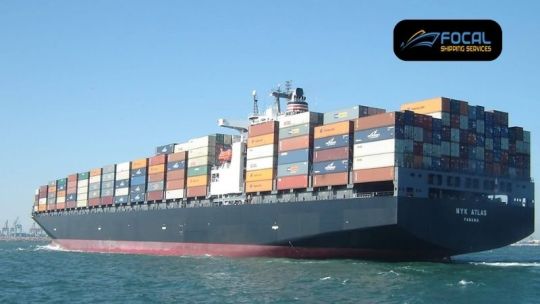
Dubai, the vibrant and bustling metropolis, stands as a symbol of economic prowess and international trade. Nestled along the Arabian Gulf, this dynamic city has evolved into a maritime hub of strategic importance, owing much of its success to the exceptional services provided by shipping companies and agents Dubai. As the lifeline of global trade, these entities play a pivotal role in connecting nations, industries, and consumers worldwide.
In this article, we embark on a voyage to explore the fascinating world of shipping companies and agents Dubai and delve into how they navigate the seas of success by facilitating seamless global trade. From the towering container ships docked at the bustling ports to the intricate logistics network that spans continents, we unravel the essence of Dubai's maritime excellence.
The strategic location of Dubai serves as a gateway between the East and West, making it an ideal juncture for shipping routes that crisscross the world's oceans. We shall witness how shipping companies and agents in Dubai capitalize on this geographical advantage to establish efficient trade routes and foster international commerce.
Through a meticulous examination, we will uncover the diverse range of services offered by shipping companies and agents in Dubai. From freight forwarding to customs clearance, vessel chartering to warehousing solutions, and everything in between, these entities serve as comprehensive facilitators for the global movement of goods.
Moreover, the article will showcase the technological advancements and digital innovations that have revolutionized the shipping industry in Dubai. Automation, real-time tracking, and data analytics have not only improved operational efficiency but also enhanced the customer experience, making the trade process smoother and more reliable.
In addition to their operational prowess, we will shed light on the sustainable practices embraced by shipping companies and agents Dubai. Amidst growing concerns about environmental impact, these entities have adopted eco-friendly initiatives and green practices, aligning with the city's vision of a sustainable future.
Furthermore, we shall explore the collaborative partnerships and strategic alliances formed by shipping companies and agents, transcending borders and fostering international cooperation. These symbiotic relationships open up new avenues for trade, promote economic growth, and strengthen global ties.
Geographical Advantage and Connectivity: Dubai's strategic location at the crossroads of Asia, Europe, and Africa has established it as a maritime gateway for global trade. Shipping companies and agents in Dubai like Focal Shipping capitalize on this unique geographical advantage to create efficient trade routes that connect continents. The city's state-of-the-art ports, such as Jebel Ali Port, act as bustling hubs for container ships and cargo vessels, facilitating the smooth movement of goods between regions. With excellent connectivity to major shipping lanes, Dubai serves as a crucial link in the global supply chain.
Comprehensive Range of Services: Shipping companies and agents Dubai offer a comprehensive range of services that cater to the diverse needs of international trade. From freight forwarding to custom brokerage, from vessel chartering to consolidation services, these entities act as one-stop solutions for businesses engaged in global commerce. They handle the complex documentation, negotiate freight rates, and ensure the timely delivery of goods to their destinations. The seamless integration of services ensures that the trade process remains efficient and cost-effective.
Embracing Technological Advancements: Dubai's shipping industry has embraced technological advancements to enhance operational efficiency and customer experience. Automation and digitalization have streamlined processes, reducing manual errors and optimizing resource utilization. Real-time tracking systems allow shippers to monitor their cargo's journey, providing transparency and peace of mind. Data analytics and artificial intelligence are employed to forecast demand, optimize routes, and improve resource allocation. These technological innovations make shipping companies and agents in Dubai more agile and responsive to the dynamic demands of global trade.
Sustainable Practices and Environmental Responsibility: Recognizing the importance of environmental sustainability, shipping companies and agents in Dubai are adopting eco-friendly practices to minimize their ecological footprint. They invest in eco-friendly vessels that are fuel-efficient and emit lower greenhouse gases. Additionally, they implement waste reduction and recycling programs at ports and terminals. Dubai's shipping industry is actively involved in initiatives to reduce marine pollution and protect marine ecosystems. By prioritizing sustainability, these entities contribute to Dubai's commitment to a greener and more sustainable future.
Collaborative Partnerships and Alliances: Collaboration is a key aspect of Dubai's shipping ecosystem. Shipping companies and agents in Dubai forge strategic partnerships and alliances with global players in the industry. These collaborations enable access to new markets, diversified service offerings, and the sharing of best practices. The cooperative nature of Dubai's shipping sector fosters a supportive environment, where expertise and resources are pooled together for mutual growth and success.
Resilience During Global Challenges: The recent global challenges, such as the COVID-19 pandemic, tested the resilience of Dubai's shipping industry. Shipping companies and agents like Focal Shipping played a vital role in ensuring the continuity of trade during lockdowns and travel restrictions. They swiftly adapted to changing circumstances, implementing health and safety protocols to protect their workforce and ensure smooth operations. The agility and adaptability displayed by Dubai's shipping industry demonstrate its unwavering commitment to global trade, even during challenging times.
Shipping companies and agents Dubai stand as key enablers of global trade, navigating the seas of success with unparalleled efficiency and dedication. With their strategic location, comprehensive services, technological innovations, and sustainable practices, these entities continue to drive Dubai's position as a maritime hub of global importance. As they collaborate, innovate, and respond to evolving trade dynamics, Dubai's shipping industry remains at the forefront of facilitating seamless global trade and supporting the growth of businesses across the world.
Our Social Media:
LinkedIn — www.linkedin.com/company/focal-shipping/
2 notes
·
View notes
Text
Unveiling the Secrets of Life Below Water: Goal 14 for a Sustainable Future
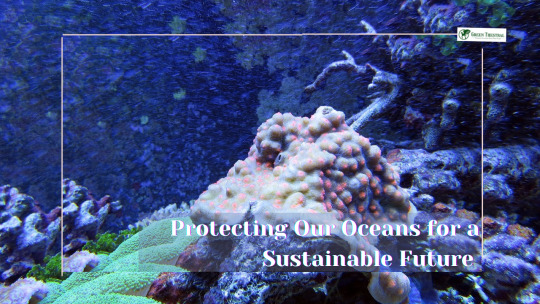
In our journey towards achieving a sustainable future, Goal 14 of the United Nations' Sustainable Development Goals (SDGs) plays a pivotal role. Life Below Water, as it is commonly referred to, focuses on the preservation and sustainable use of oceans, seas, and marine resources. With this goal, the international community aims to safeguard marine ecosystems, mitigate the impacts of human activities, and promote sustainable livelihoods for coastal communities. This article delves into the significance of Goal 14, explores the challenges faced, and highlights the initiatives that can help us ensure a healthier and more vibrant life below water.
Understanding the Importance of Goal 14
The Earth's oceans are vast and cover more than 70% of the planet's surface. They are teeming with life and harbor a remarkable diversity of species and ecosystems. From the mesmerizing coral reefs to the mysterious depths of the abyss, the oceans are a treasure trove of biodiversity, supporting millions of species, including plants, animals, and microorganisms.
Beyond their ecological significance, the oceans play a crucial role in regulating the Earth's climate. They act as a massive heat sink, absorbing a significant amount of the sun's energy and distributing it across the planet. Additionally, oceans play a vital role in the water cycle, facilitating the evaporation of water, which then falls as precipitation and sustains terrestrial ecosystems.
The oceans are not only important for the environment but also for human societies. They provide sustenance to millions of people around the world. Fishing, both for subsistence and commercial purposes, is a primary source of livelihood for coastal communities. The oceans also support economic activities such as tourism, shipping, and offshore industries, contributing significantly to global economies.
However, the delicate balance of marine ecosystems is under threat due to various human activities. Overfishing, driven by unsustainable practices and the demand for seafood, has led to the depletion of fish stocks worldwide. Large-scale industrial fishing, with destructive methods such as bottom trawling, threatens not only the targeted species but also the entire marine food web.
Marine pollution is another significant challenge faced by the oceans. Pollution from land-based sources, including plastic waste, chemicals, oil spills, and agricultural runoff, finds its way into the marine environment, causing severe harm to marine life and ecosystems. The accumulation of plastic debris in the oceans has reached alarming levels, forming giant garbage patches and causing entanglement and ingestion by marine organisms.
Habitat destruction and degradation are also taking a toll on marine ecosystems. Destructive practices such as coral reef destruction, coastal development, and the destruction of mangroves and seagrass beds result in the loss of critical habitats and the disruption of delicate ecological relationships. These habitats serve as nurseries and breeding grounds for many species, and their loss has far-reaching consequences for marine biodiversity.
Furthermore, climate change poses one of the most significant threats to life below water. Rising sea temperatures, ocean acidification, and sea-level rise are already impacting marine ecosystems. Corals, which are vital for the survival of countless marine species, are particularly vulnerable to rising temperatures and increased ocean acidity, leading to coral bleaching events and the degradation of coral reefs.
In recognition of the urgent need to protect and sustainably manage marine resources, Goal 14 of the United Nations' Sustainable Development Goals (SDGs) was established. Also known as Life Below Water, this goal aims to ensure the conservation and sustainable use of the oceans, seas, and marine resources for present and future generations.
Goal 14 encompasses various targets and indicators to guide efforts towards sustainable ocean management. One of the key focuses is the protection and restoration of coral reefs, which are among the most diverse and valuable ecosystems on Earth. Coral reefs provide habitat for numerous species, protect coastlines from erosion, and support vibrant tourism industries. By implementing measures to reduce coral bleaching, enhance reef resilience, and combat destructive practices, Goal 14 seeks to safeguard these vital ecosystems.
Another critical aspect of Goal 14 is the reduction of marine pollution. It calls for the prevention and significant reduction of marine debris, particularly plastic waste. Efforts are being made to promote better waste management systems, recycling and reusing plastics, and raising awareness about the detrimental effects of single-use plastics. Innovative technologies for ocean cleanup are also being developed to tackle existing pollution.
To address the issue of overfishing, Goal 14 emphasizes the need to restore fish stocks to sustainable levels. This involves implementing science-based management plans, combating illegal, unreported, and unregulated fishing, and promoting responsible fishing practices. Creating marine protected areas and adopting ecosystem-based management approaches can help protect critical habitats and ensure the long-term viability of fisheries.
Furthermore, Goal 14 acknowledges the urgent need to address ocean acidification, which poses a grave risk to marine organisms. By reducing carbon dioxide emissions and taking steps to enhance the resilience of marine ecosystems, such as protecting mangroves and seagrass beds, this goal aims to mitigate the impacts of ocean acidification and ensure the survival of vulnerable species.
Achieving Goal 14 requires a collaborative effort from governments, businesses, civil society organizations, and individuals worldwide. International cooperation is crucial to strengthen governance frameworks, regulate resource exploitation, combat illegal fishing, and promote sustainable practices. By taking collective action and embracing sustainable approaches, we can secure a healthier and more vibrant future for life below water.
Challenges and Threats to Life Below Water
The life below water faces a multitude of challenges that require immediate attention and concerted efforts. Overfishing, driven by unsustainable practices and illegal, unreported, and unregulated fishing, has led to a decline in fish stocks worldwide. The loss of biodiversity affects not only marine ecosystems but also the communities that depend on them for food security and economic opportunities.
Marine pollution poses another significant threat. Plastic waste, chemicals, oil spills, and other pollutants contaminate the oceans, harming marine life and ecosystems. The accumulation of plastic debris, in particular, has gained global attention due to its devastating impact on marine organisms and the potential consequences for human health through the food chain.
Ocean acidification, caused by the absorption of excess carbon dioxide from the atmosphere, poses a grave risk to marine organisms such as corals, shellfish, and plankton. Acidic waters can hinder the growth and survival of these organisms, disrupting the entire marine food web and impacting the livelihoods of coastal communities.
Initiatives and Solutions for a Sustainable Life Below Water
Achieving Goal 14 requires a comprehensive approach involving governments, businesses, civil society, and individuals. Several initiatives and solutions have emerged to address the challenges faced by life below water:
Sustainable Fisheries Management: Implementing science-based management plans, promoting responsible fishing practices, and combating illegal fishing are crucial steps towards replenishing fish stocks and ensuring the long-term sustainability of fisheries. Tools like marine protected areas and ecosystem-based management help preserve critical habitats and protect biodiversity.
Marine Pollution Prevention: Reducing plastic pollution and other sources of marine debris is vital. This can be achieved through improved waste management systems, recycling and reusing plastics, and raising awareness about the consequences of single-use plastics. Additionally, promoting the use of biodegradable alternatives and supporting innovative technologies for ocean cleanup can help mitigate the impact of existing pollution.
Climate Change Mitigation and Adaptation: Addressing climate change is fundamental to preserving life below water. Transitioning to renewable energy sources, reducing greenhouse gas emissions, and promoting sustainable coastal development are essential steps in mitigating the impacts of climate change on marine ecosystems. Additionally, enhancing the resilience of coastal communities through measures such as mangrove restoration, coastal protection, and sustainable tourism can aid adaptation efforts.
International Cooperation and Governance: Collaboration among nations is crucial for the effective implementation of Goal 14. Strengthening international frameworks, such as the United Nations Convention on the Law of the Sea (UNCLOS), and promoting regional cooperation can help combat illegal fishing, regulate resource exploitation, and ensure the sustainable use of marine resources.
Conclusion
Preserving life below water is not only crucial for the health of our oceans but also for the overall well-being of our planet. Goal 14 provides a roadmap for sustainable ocean management, aiming to conserve marine biodiversity, mitigate pollution, and promote the sustainable use of marine resources. By taking action at individual, local, and global levels, we can make a significant difference in ensuring a healthier and more vibrant future for life below water. Let us join hands and work together to safeguard the oceans for generations to come.
#Sustainable management of marine resources#Conserving marine biodiversity#Protecting coral reefs and marine ecosystems#Sustainable fishing practices for life below water#Reducing marine pollution for a healthier ocean#Restoring fish stocks for sustainable fisheries#Addressing the threats of overfishing#Combating illegal fishing activities#Preserving the delicate balance of marine ecosystems#Tackling plastic pollution in the oceans#Solutions for ocean acidification#Climate change impact on life below water#Sustainable tourism and the oceans#Promoting responsible coastal development#Achieving United Nations' Goal 14 for a sustainable future#Enhancing resilience of coastal communities#Sustainable livelihoods for coastal populations#Importance of ocean conservation and sustainability#Preserving marine habitats and species diversity#Ecosystem-based management for marine resources#Strengthening international cooperation for Goal 14#Achieving sustainable development through Goal 14#Role of marine protected areas in conservation#Long-term viability of marine ecosystems#Promoting sustainable shipping practices#Economic benefits of sustainable ocean management#Balancing human activities with marine conservation#The significance of Goal 14 in the SDGs#Ensuring a vibrant future for life below water#Global initiatives for the protection of marine environments
2 notes
·
View notes
Text
Sustainable Fashion Revolution: The Ultimate Guide to Dress Responsibly and Look Fabulous in 2023

Introduction
Sustainable fashion has gained significant attention in recent years, as consumers and brands alike are becoming more aware of the negative impact of the fashion industry on the environment and society. Sustainable fashion refers to the production, use, and disposal of clothing items in an environmentally responsible and socially conscious manner. Here are some key takeaways from the provided web search results regarding sustainable fashion and how it can help us dress responsibly in 2023:
- Sustainable fashion is an emerging trend in the fashion industry, but progress remains slow .
- Creating a greener wardrobe is a simple step towards sustainability. It involves taking stock of your existing wardrobe, choosing sustainable fabrics, and supporting sustainable brands .
- Sustainable fashion brands use natural or recycled fabrics that require less or no chemical treatment, less water, and less energy. Some of the most sustainable fabrics include linen, hemp, organic cotton, and Tencel .
- There are several sustainable fashion brands that offer stylish and environmentally friendly clothing options. These brands source upcycled fabrics and eco-minded materials for their clothing, and prioritize ethically sourced and sustainable materials and working conditions. Some of the top sustainable fashion brands include Christy Dawn, Reformation, Cuyana, Amour Vert, Whimsy + Row, and Mara Hoffman .
- Sustainable fashion is a key step towards dismantling the fast fashion industry, which is responsible for more greenhouse gas emissions than the shipping and aviation industries combined .
- Sustainable fashion is also gaining traction among consumers. A 2020 report on sustainability in fashion found that 67% of shoppers now consider environmentally friendly fabrics when choosing a brand .
- The fashion industry is taking steps towards sustainability, such as Copenhagen Fashion Week's sustainability requirements for participating designers, with the goal of setting a new industry standard .
In conclusion, sustainable fashion is a key aspect of dressing responsibly in 2023. By choosing sustainable fabrics, supporting sustainable brands, and taking steps towards a greener wardrobe, we can contribute to a more environmentally friendly and socially conscious fashion industry.
Sustainable Materials for Fashion

Sustainable fashion has gained increasing attention in recent years due to the negative environmental impact of the fashion industry. Several sustainable materials can be used in a fashion that minimizes waste, reduces carbon emissions, and conserves natural resources. Some of the most commonly used sustainable materials in fashion include organic cotton, recycled cotton, hemp, linen, bamboo, cork, ECONYL® recycled polyester, Lyocell, Modal, ECOVERO™, Piñatex, and Bananatex® .
The fashion industry's conventional raw materials sourcing has contributed significantly to the planet's declining health, including petroleum refining for polyester, water contamination and depletion, soil degradation, and deforestation for industrial cotton and viscose production. Consequently, the industry is turning to sustainable materials that prioritize the environment and promote ethical practices in production.
Polyester, which accounts for approximately 65% of all clothing, is produced from fossil fuels and consumes 70 million barrels of oil annually, causing significant pollution to the environment. Similarly, the fashion industry uses considerable amounts of fossil fuel-based plastic for packaging and hangers. Less than one per cent of clothing is recycled to make new clothes, which contributes to significant waste generation in the industry .
Wool is another sustainable fabric that can be produced sustainably, depending on how it's made. Climate Beneficial™ Wool produced on carbon farming landscapes captures carbon and puts it back into the soil. Wool is also compostable, insulating, and does not shed plastic microfibers .
Several sustainable materials are emerging, and luxury brands are turning to them to respond to customer demand for greener textiles. Examples include mushroom leather and pineapple fabric, which are gaining popularity and could play a significant role in sustainable fashion in the future .
Several sustainable fashion brands prioritize using sustainable materials in their production, including Outerknown, which sources 90% of its fibres from sustainable materials such as recycled mango fruit, organic cotton, recycled Polyurethane (PU) leftovers, and environmentally-certified leather. Similarly, Reformation, based in Los Angeles, uses upcycled sneakers made of sustainable materials such as recycled mango fruit, organic cotton, recycled Polyurethane (PU) leftovers, and environmentally-certified leather. .
Other sustainable materials include linen and hemp, which were commonly used in clothing in the past. Hemp is three times stronger than cotton, UV-resistant, durable, breathable, and can be grown without fertilizer or pesticides. It also requires less water to grow compared to cotton . Recycled plastic bottles are also a sustainable material used in fashion production, and they are being adopted by many designers due to their eco-friendliness .
In conclusion, several sustainable materials are available for use in fashion production, ranging from organic and recycled cotton, hemp, linen, and bamboo to mushroom leather and pineapple fabric. Sustainable fashion brands prioritize
The Rise of Recycled Materials in Sustainable Fashion
Sustainable fashion has become a growing trend in the fashion industry, and the use of recycled materials is one of the ways that fashion brands are becoming more eco-friendly. Recycled materials, such as organic cotton, hemp, and linen, are being used in fashion lines to reduce waste and carbon emissions. Some fashion brands are even implementing compostable packaging and branding to further reduce their environmental footprint .
The use of recycled materials in sustainable fashion is not only beneficial to the environment but it can also be implemented through fair labour practices, such as the Maasai beadwork. Additionally, upcycling, a process that transforms waste and byproducts of manufacturing into new products, has gained popularity in the fashion industry. Designers like Ancuta Sarcas have even started upcycling discarded Nike shoes and high-waste materials like mesh to create unique fashion pieces .
The COVID-19 pandemic has further accelerated the demand for eco-friendly fashion. Fashion brands, manufacturers, and traders are looking at more sustainable approaches to meet the market demand for products meeting environmental, social, and governance (ESG) criteria. Carbon emissions reduction is also one of the targets of global efforts to promote sustainable economic development .
Overall, recycled materials are becoming increasingly prevalent in a sustainable fashion as designers and brands look for ways to reduce waste and carbon emissions while still producing stylish and unique fashion pieces.
Organic Cotton: The Benefits for the Environment and Your Wardrobe
Organic cotton is cotton grown without the use of synthetic chemicals such as fertilizers, pesticides, or genetically modified organisms (GMOs). It offers various benefits to the environment and to the people wearing the clothes made from it.
One of the most significant benefits of organic cotton is that it requires much less water to grow compared to conventional cotton. The farming process used in organic cotton production relies on rainwater for about 80% of its needs, resulting in approximately 71% less water used overall . Additionally, organic cotton cultivation methods avoid the use of synthetic fertilizers, which can lead to soil degradation and pollution of water sources, ultimately helping to prevent water contamination .
Furthermore, organic cotton production methods play a role in mitigating climate change by avoiding the use of synthetic chemicals, reducing energy consumption, and sequestering carbon more efficiently in healthier soils . As such, it has been established that organic cotton cultivation has significant environmental benefits, such as promoting biodiversity, reducing greenhouse gas emissions, and helping to prevent soil erosion and degradation .
Aside from its environmental benefits, organic cotton is also better for the farmers who grow it. They are not exposed to harmful chemicals that can cause a range of health problems, including respiratory issues and cancer . Moreover, organic cotton is also softer and less likely to cause irritation than conventional cotton, making it a better choice for those with sensitive skin .
In summary, the benefits of organic cotton are numerous, and it is an excellent choice for those looking to reduce their impact on the environment while also supporting the health and well-being of farmers and consumers.
The Future of Sustainable Textiles: Innovations and Breakthroughs
Sustainable textiles are becoming increasingly important in the fashion industry. Several recent developments suggest that innovative and groundbreaking new textiles are on the horizon. Researchers at MIT are exploring the intersection of textile research and sustainable materials, seeking potential synergies that could advance the field . McKinsey and Company predict that there will be significant growth in sustainable fashion consumption, particularly in products made from more sustainable materials such as organic cotton . Science Daily reports on new textiles that can change shape when heated, potentially offering designers a wide range of new options for responsive and adjustable aesthetics . Drapers Online covers a variety of textile innovations, offering insights into the latest developments in the industry . Finally, the European Commission has launched a roadmap for the future of sustainable textiles in the EU, outlining efforts to increase the circularity of the fashion ecosystem . With these developments and more, it seems clear that sustainable textiles are an area of rapid innovation and growth, and we can expect exciting breakthroughs in the near future.
The Circular Fashion Movement

The Circular Fashion Movement is a growing global trend in the fashion industry that aims to promote sustainable and responsible production and consumption of clothing while reducing the negative impact of the fast fashion industry on the environment and society. Circular fashion involves designing, producing, and using clothes that are meant to be used and circulated responsibly and effectively for as long as possible, and then safely decomposed or repurposed when they are no longer of use to humans .
The movement has gained significant momentum in recent years, with numerous fashion brands and organizations committing to circularity commitments and initiatives, such as take-back and resale programs, upcycling, and closed-loop production systems . The Circular Fashion Pledge is a simple concept that asks fashion brands to pledge to one or more circularity commitments by the end of the calendar year, such as enabling take-back or resale programs .
Circular fashion has been identified as a key solution to the environmental and social challenges posed by the fast fashion industry, including waste, pollution, exploitation of labour, and depletion of resources . The movement has also gained significant attention and support from sustainability experts and advocates, who believe that it can help to create a more equitable, resilient, and sustainable fashion industry that benefits both people and the planet.
Overall, the Circular Fashion Movement represents a growing global trend towards more sustainable and responsible fashion production and consumption and has the potential to revolutionize the way we approach clothing and fashion in the future.
Understanding Circular Fashion: What It Is and Why It Matters
Circular fashion is a concept that has emerged from the intersection of the circular economy and sustainable and ethical fashion . Essentially, it refers to a system in which all garments can be reused, recycled, or returned to the earth (by virtue of being biodegradable or compostable), reducing the hugely damaging impact the fashion industry has on the planet . In other words, products are designed and developed with the next use in mind, with the aim of keeping resources in use for as long as possible and minimizing waste .
The fashion industry has long been known for its negative impact on the environment, including the strain on natural resources, the vast amount of CO2 emissions it produces, and the giant heaps of clothing that end up in landfills . Circular fashion is one solution to this problem, as it aims to reduce the harmful impact of fast fashion by circulating and reusing articles for as long as possible before decomposing them safely .
Circular fashion also means using sustainable and natural materials in production, such as organic cotton, bamboo, and Tencel, and avoiding synthetic and plastic fabrics like polyester and nylon derived from fossil fuels . Additionally, the production and transport of items should be powered by renewable energy sources .
In summary, circular fashion is a sustainable and ethical approach to fashion that aims to reduce waste and minimize the harmful impact of the industry on the environment. It involves reusing, recycling, and upcycling as much as possible, using sustainable and natural materials, and powering production and transport with renewable energy sources .
From Cradle to Cradle: The Principles of Circular Fashion Design
Circular fashion design principles are heavily influenced by the cradle-to-cradle (C2C) approach, which is a design framework for creating products that mimic natural systems and support the circular economy. The C2C approach promotes the high-quality use and circulation of biological and technical nutrients, protecting and enriching ecosystems while enabling economic productivity . The aim of the C2C approach is to optimize products from the molecular to modular level and establish these principles in all industry sectors, including the textile industry, consumables, buildings, automotive, packaging, and cosmetics .
Circular fashion design principles follow the four principles of the circular economy: preservation of natural capital, optimization of available resources, risk reduction, and renewable flow of resources and products . The principles of circular fashion design also emphasize the importance of planning the entire lifecycle of a product at the design stage, incorporating aspects such as sustainable materials, biodegradability, recyclability, and durability. Circular fashion aims to eliminate waste, pollution and the negative environmental impact of the fashion industry, by designing products for reuse, recycling, and composting .
Closing the Loop: How Brands are Embracing Circular Fashion
Circular fashion refers to a closed-loop system that rethinks and redesigns the way products are made, used, and discarded to reduce waste and promote sustainability. Many fashion and luxury companies, including LVMH, Kering, H&M, VF Corp, and Gap, have embraced circularity as a way to reduce their environmental footprint . A fully closed-loop apparel recycling system in California could achieve a total holistic impact of $11 billion to $13 billion a year, based on the estimate of the total holistic impact of approximately $5.5 billion to $6.5 billion from closed-loop recycling of polyester, which represents a significant portion of textile production . In order to combat unethical practices in the fashion and textile industry, the industry must embrace a closed-loop system, rethinking and redesigning the way products are made, used, and discarded . Many fashion brands are now working towards closing the loop on waste and promoting circular design, such as Loop Swim, a brand that transforms post-consumer plastic bottles into sun-protective swimwear . In February 2022, Reformation launched RefRecycling, a program that allows customers to return any well-worn Ref goods to the company to be recycled, thus promoting circular fashion and reducing waste .
Ethical and Slow Fashion
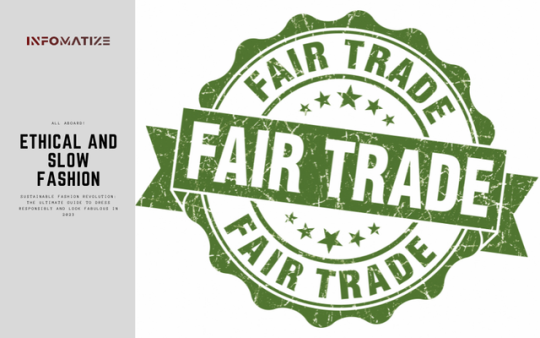
Ethical and slow fashion are two related concepts that are gaining more attention in the fashion industry. While they share some similarities, they also have distinct differences.
Ethical fashion focuses on ensuring fair treatment of workers throughout the supply chain, from safe working conditions to fair wages and eliminating child and slave labour . It also considers the treatment of animals, making sure that the materials used in clothing production are cruelty-free . On the other hand, slow fashion is about producing high-quality, timeless clothing that is sustainable and environmentally friendly . Slow fashion leans into sustainable practices, such as using eco-friendly materials and minimizing waste .
Both ethical and slow fashion is countercultural, going against the current societal norms that prioritize fast and cheap production over ethical and sustainable practices. Hallmarks of slow fashion include longer production timetables, fewer items produced, and more ethical labour practices, with an emphasis on creating timeless pieces that will stand the test of time .
In summary, ethical fashion is focused on the fair treatment of workers and animals throughout the supply chain, while slow fashion is about sustainable and timeless clothing production. Both concepts are aimed at creating a more sustainable and ethical fashion industry, challenging the norm of fast and cheap fashion production.
Slow Fashion: The Antidote to Fast Fashion
Slow Fashion is an approach to clothing production that takes into account all aspects of the supply chain, including the environmental and social impact, as well as animal welfare. It aims to create sustainable, ethical, and high-quality garments, produced on a smaller scale with more eco-conscious materials and locally manufactured to reduce transportation and promote fair wages for workers . In contrast to fast fashion, where clothing is produced quickly and cheaply with a focus on trends and low prices, slow fashion considers the long-term impact of the production process and encourages consumers to value quality over quantity .
If you're interested in adopting slow fashion practices, here are a few tips to get started:
- Have a clear-out of your closet and donate or sell the clothes you don't wear anymore to avoid cluttering and promote the use of existing garments .
- Buy clothes made from sustainable and eco-friendly materials such as organic cotton, recycled fabrics, or biodegradable fibres .
- Choose locally-produced garments to support your community and reduce the environmental impact of transportation .
Read the full article
#Consciousfashion#Eco-consciousfashion#Eco-friendlyclothing#Eco-friendlyfashion#Ethicalclothing#Ethicalfashion#Fashionrevolution#Responsiblefashion#Slowfashion#Sustainableclothingbrands#Sustainablefashion#Sustainablefashionbloggers#Sustainablefashionbrands#Sustainablefashionforallages#Sustainablefashionforallbeliefs#Sustainablefashionforallbodytypes#Sustainablefashionforallbudgets#Sustainablefashionforallcelebrations#Sustainablefashionforallclimates#Sustainablefashionforallcultures#Sustainablefashionforallethnicities#Sustainablefashionforallevents#Sustainablefashionforallgenders#Sustainablefashionforallhobbies#Sustainablefashionforallholidays#Sustainablefashionforallinterests#Sustainablefashionforalllifestyles#Sustainablefashionforalllocations#Sustainablefashionforallnationalities#Sustainablefashionforalloccasions
2 notes
·
View notes
Text
THE WILD BLUE YONDER!
Lucy & Aviation

Thanks to Orville and Wilbur Wright, the world became a smaller place and travel by air become as commonplace as train or car travel. Lucille Ball and her many characters had lots of reasons to take to the ‘friendly skies’ - here are just a few.
Orville and Wilbur Wright were inventors and pioneers of aviation. In 1903 the Wright brothers achieved the first powered, sustained and controlled airplane flight; they surpassed their own milestone two years later when they built and flew the first fully practical airplane. The Wrights were mentioned several times in the Lucyverse:
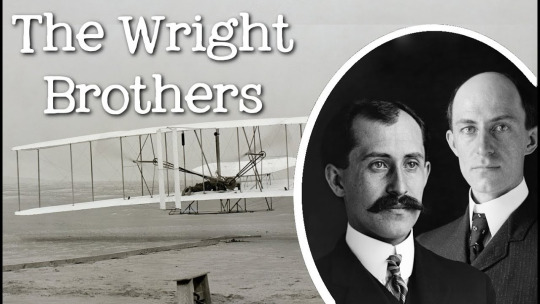
Olin Howland (Mr. Skinner in “First Stop” 1955) ~ As a young man he learned flying from the Wright Brothers.
“Speech for a Civic Organization” (1949) ~ Liz intends to speak about the Wright Brothers, despite her favorite husband’s objections.
“The Good Years” (1962) ~ Orville and Wilbur were mentioned in the special starring Lucille Ball and Henry Fonda.
“Swing Out Sweet Land” (1970) ~ Rowan and Martin played the Wright Brothers and Lucy voiced the Statue of Liberty in John Wayne’s TV special celebrating American history.

As a busy radio, film and television star, Lucille Ball was constantly photographed boarding and disembarking from aircraft.

1930′s ~ Young model Lucille Ball holds a model airplane for a photo shoot.

May 1938 ~ Publicists created fascinating and completely untrue backgrounds for Hollywood stars. In this article, Monroe Lathrop claims that Lucille Ball was a skilled aviatrix who shot crocodiles while flying over a jungle river.
“On a visit to Colombia, Lucille, avid for new adventure, went with friends Into the jungle, meeting a flood that had swollen the streams and overrun the banks with huge crocodiles. Instead of heeding the natives' warning, Lucille went to wireless station, ordered an airplane and rifles, and spent a day pumping lead into the big green saurians. Natives rewarded her with a generous helping of crocodile steak later.”

Five Came Back (1939) ~ Nine passengers from all walks of life and a crew of three take off from Los Angeles, bound for Panama City, but a sudden storm blows them off course and causes the plane to crash in the Amazon jungle. Lucille Ball played passenger Peggy Nolan. The B film helped Ball launch an A list career.
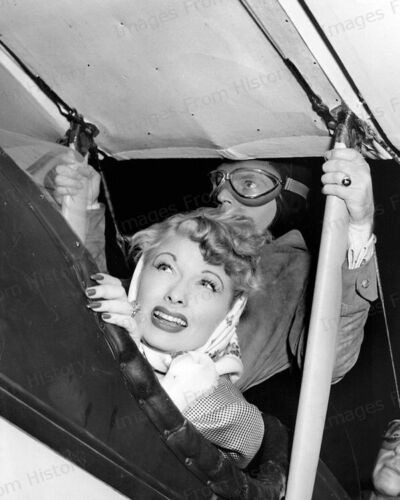
1940s ~ Lucille Ball posing in a biplane cockpit.
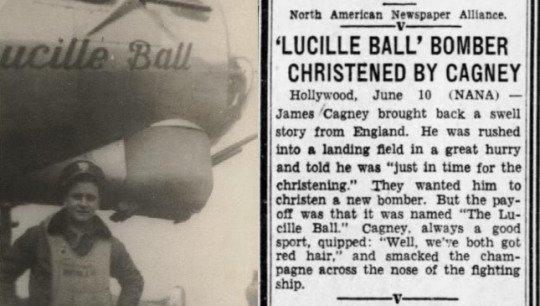
June 1943 - Newspapers reported that Jimmy Cagney had christened a B-17 bomber named The Lucille Ball. After it was scrapped due to battle damage, a second bomber was christened The Lucille Ball in 1944.

A Woman of Distinction (1950) ~ Lucille Ball appears in a cameo as herself, a jet-setting film star, in this Rosalind Russell / Ray Milland film.

“Return Home From Europe” (1956) ~ To get back to New York in time to play the Roxy, the Ricardos and Mertzes fly home from Europe, rather than go by ship. Unable to whittle down her luggage allowance, Lucy is intent on smuggling a cheese aboard, disguising it as a baby.
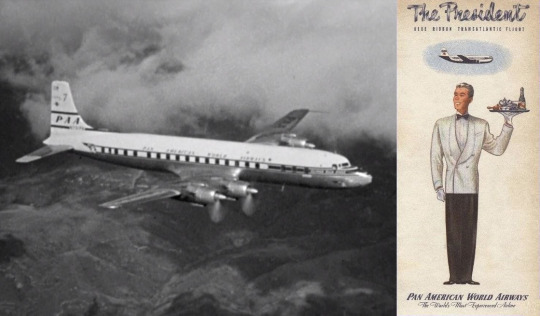
There are establishing shots of Pan American World Airways (PAA) President Clipper Service. The Clipper in the insert shot is named Bald Eagle. There are two insert shots of Pan Am aircraft: one taking off, and one in mid-flight. The DC-7C (nicknamed “seven seas”) first entered service for Pan Am in December 1955 and was dubbed “the zenith of piston-engine technology.” Pan Am had 27 DC-7Cs flying during 1956. By 1958, jet travel began to overtake propeller airplanes.

The interior of the aircraft was recreated on the Desilu soundstage. The PAA logo is visible on blankets and tote bags, items provided by Pan Am for the use of their name and images of their aircraft as well as possible other promotional consideration.

“The Ricardos Visit Cuba” (1956) ~ While in Miami, the gang flies to Havana to visit Ricky’s family.

The gang once again flies Pan American Airways, the same carrier they took home from Europe. The airline folded in 1991.

As with their previous flight, there is an establishing shot of the plane in the air and the interior was recreated on the Desilu soundstage. The set is basically the same one used in “Return Home from Europe”. It also features PAA branded promotional items.

“Lucy Goes To Alaska” (1959) ~ The Ricardos and Merztes fly to the brand new state of Alaska, where Ricky and Fred have bought some land and Ricky is doing a TV show with Red Skelton. Although the action is set in and around Nome, the second unit footage was filmed in Lake Arrowhead, California, about 100 miles from Hollywood. The exteriors were done with doubles and none of the regular cast left their newly-purchased Desilu (formerly RKO) Studio.

To get from Westport CT to Nome AK, the gang first flies United Airlines, then transfers to Alaska Airlines. There is establishing footage of both planes in mid-flight.

The set features a couple of travel posters for Alaska Airlines, enticing viewers to visit the 49th state for tourism. In the second half of the hour, a small propeller plane is introduced to rescue Red and Lucy from a blizzard.

RED: “What’s that blue stuff?”
ESKIMO PILOT: “Sky.”
LUCY (To Red): “You act as though you’ve never seen sky before.”
RED: “I haven’t. I live in Los Angeles.”

The plane is buried in a snowbank. Lucy pays an eskimo pilot $100 to fly her and Red to safety.

While the plane in the snowbank was filmed in the Hollywood studio, the safe landing was done at Lake Arrowhead using actor doubles.

“The Ricardos Go To Japan” (1959) ~ The final time we see the gang airborne is on a trip to Japan. Although there is a poster for Japan Airlines (JAL) in the airport...

According to the establishing footage of the jet in mid-air, the foursome travels on United Airlines.

The Facts of Life (1960) ~ The film about two marrieds flirting with infidelity has Kitty Weaver (Lucille Ball) waiting at the airport where a United Airlines jet can be seen on the tarmac in the background.

“Mr. & Mrs.” aka “The Lucille Ball Comedy Hour” (1964) ~ A comedy special in which Lucille Ball plays the head of a studio trying to track down Bob Hope to star in a show about husband and wife television stars. The first half concerns Lucy's tracking the elusive Hope all around the world. In San Francisco, there is establishing footage of a jet landing which was supplied courtesy of TWA, a carrier that went out of business in 2001.

“The Victor Borge Comedy Theatre” (1962) & “Lucy Flies To London” (1966) ~ The unaired pilot for an unsold comedy anthology series hosted by Borge featured a sketch starring Gale Gordon and Lucille Ball as two strangers on a plan.

It was filmed before “The Lucy Show” paired the two as a comedy duo. In the pilot, the characters were strangers. Gordon played a businessman and Ball a neurotic first-time flyer.

When it came time for Lucy Carmichael to fly to London for the special “Lucy in London”, the writers realized they could recycle the script from the un-aired pilot for “The Lucy Show” episode. The dialogue is nearly identical, now with the added context that Mr. Mooney and Lucy are boss and secretary.

“Lucy in London” (1966) ~ An hour-long special set in England and filmed on location. The sequence involving Lucy de-planing from the Pan Am clipper jet had to be accomplished in between flights already on the tarmac at Heathrow. No planes were available to be grounded for a day of shooting. Coincidentally (or perhaps not) Pan Am was also the carrier when Lucy Ricardo flew home from Europe and from Miami to Havana on “I Love Lucy.”
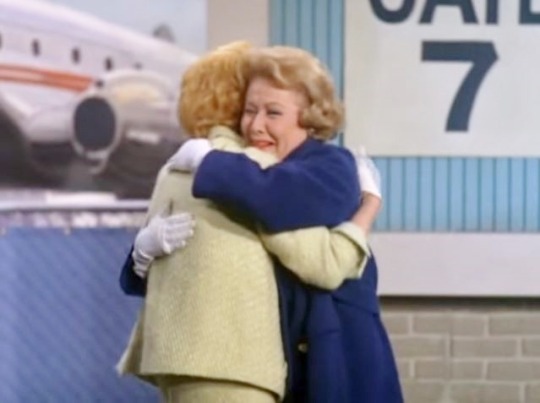
“Viv Visits Lucy” (1967) ~ To greet her old friend, Lucy meets her at the airport, where a backdrop shows jets on the tarmac. Lucy looks up and sees Viv’s flight approaching.
LUCY: “Oh, look! Someone’s hanging out of the plane. It look like Viv!”
PILOT: “That’s the landing gear.”
LUCY: “Oh.”

“Little Old Lucy” (1967) ~ When the 90 year-old president of the bank (Dennis Day) is in town and needs an escort to the bank’s banquet, Lucy is volunteered. Lucy and Mr. Mooney meet him at the airport, where jets can be seen in the background.

“Lucy and Carol Burnett: Part 1 & 2″ (1967) ~ Lucy and Carol Tilford (Carol Burnett) sign up to be flight attendants, then put on a variety show celebrating aviation. They are employed by the fictional Globe World Airlines.
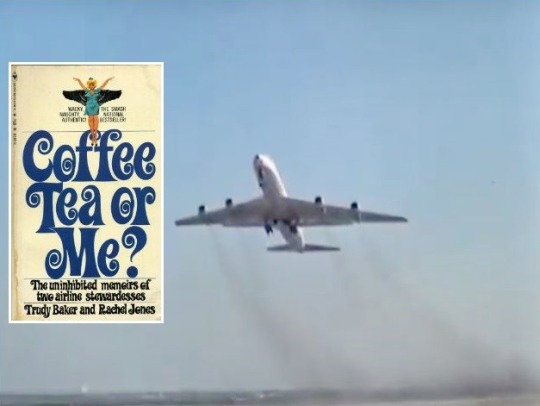
Instead of asking bachlor GWA VP Mr. Brenner if he would like coffee, tea or milk, Lucy says “coffee, tea or me”! Earlier in 1967, the book Coffee Tea or Me? was published. It was the alleged memoirs of two stewardess and their romantic and sexual escapades in the air. The popularity of this book may be the reason for this episode.
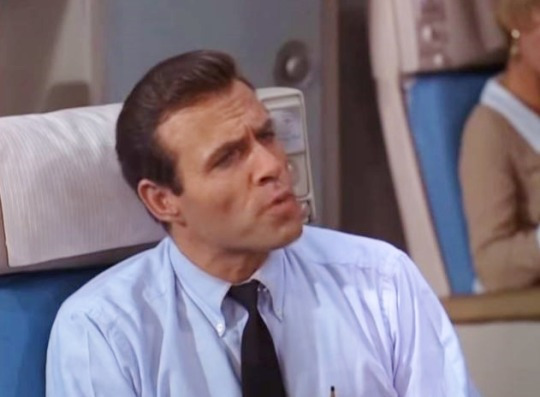
Frustrated by Lucy and Carol's bungling, Mr. Brenner (Rhodes Reason) says “Is this any way to run an airline?” The line gets a huge reaction from the studio audience. In 1963 a National Airlines TV commercial featured a flight attendant asking “Is this any way to run an airline? You bet it is!” In 1966, singer Tom Paxton wrote and recorded a song with the same title.

In Part Two, their musical salute to aviation features Buddy Rogers and Richard Arlen, stars of the very first Academy-Award winning motion picture Wings (1929), a movie about flight. Coincidentally, on the same day this airline-themed episode premiered, the supersonic Concorde was unveiled in France. Also on this date, newspapers announced the crash of a twin-engine plane in Madison, Wisconsin that killed recording star Otis Redding and six others.

The revue ends with “The Army Air Corps Song” with flight attendants and college boys perched on the wings of a bi-plane.

“Lucy and the Great Airport Chase” (1969) ~ Filmed entirely on location at Los Angeles International Airport (LAX), Lucy and Harry get caught up in chasing down spies. Part of the chase takes them onto the tarmac with the jets.

A Douglas DC-8-52 of United Airlines is on the right and Douglas DC-8-54AF Jet Trader of United Airlines Jet Freighter is in the background.

“The Carol Burnett Show” (1969) ~ In a sketch, Lucy and Carol play flight attendnts and Harvey Korman plays a mysterious passenger with a Fidel Castro-like beard, cigars tucked in his breast pocket, and a Spanish accent. When this episode was aired, hijackings were in the news.

“Lucy, the Sky Diver” (1970) ~ Trying to show her kids how dangerous their hobbies are, Lucy jumps from a plane! Although there is second unit location footage of the plane and Lucy floating down on her parachute, Lucille Ball remained at the studio with a recreation of the aircraft and a simulated parachute.

“Lucy, the Part-Time Wife” (1970) ~ Lucy and Harry go to the airport to meet an old flame of his (Carole Cook). The airport background shows jets on the tarmac.
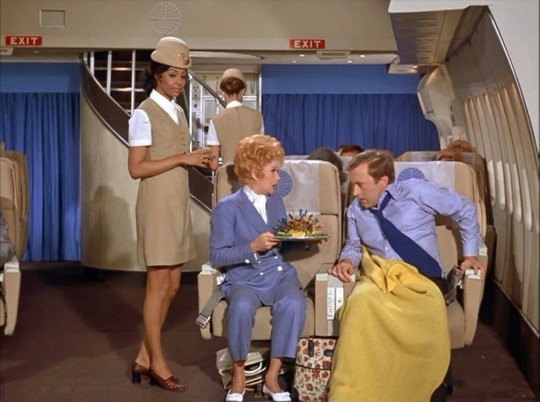
“Lucy Helps David Frost Go Night-Night” (1971) ~ Lucy takes an assignment accompanying David Frost on a transatlantic flight so that he can get some rest. Thanks to Lucy, his flight is anything but restful! The first class section of a 747 was recreated for the episode.

The jet seen in the stock footage of the airport is a Pan Am Boeing 747 with an upper deck first class lounge.

David Frost reckons that he has taken 346 air trips or traveled 1,853,000 miles!

Mame (1974) ~ At the end of the film, Auntie Mame waves goodbye to Patrick, has she flies off to her next adventure.

“Lucy Gets Lucky” (1975) ~ Although Lucy Collins took the bus to Las Vegas to see her favorite star Dean Martin, at the end of the special she flies off into the sunset with him on his private jet. Dreams come true!
#Lucille Ball#Desi Arnaz#Vivian Vance#William Frawley#I Love Lucy#The Lucy Show#Here's Lucy#TV#airplanes#jets#airlines#Pan Am#TWA#David Frost#Carole Cook#Harvey Korman#Carol Burnett#Wings#Buddy Rogers#Richard Arlen#Five Came Back#Alaska Airlines#Japan Airlines#A Woman of Distinction#Gale Gordon#CBS#Lucy Gets Lucky#Mr. & Mrs.
6 notes
·
View notes
Text
Ofmd fanfic stupid idea two because I’m feral and this one is so long omg I’m sorry
Okay so I’m still a bit tipsy and feral but here we go (there will be a pt2 here this is so long omg)
Idea 2: the age of pirates is being threatened by the crowns of Europe by employing pirate hunters (aka ex pirates who are killing others for money). Ed is unbothered until he gets wind of some of the names that have turned against them all, including Hornigold. Izzy is properly mad (aka worried) and wants to know what the plan is because of course Hornigold would go after them. Ed being Ed, gets finicky and brushes Izzy saying it’ll be fine. Stede being Stede is slightly worried but greatly over exaggerates the crews abilities and so nothing happens. Until a ship finds them. Luckily it’s not Hornigold but it is *insert pirate here*. The revenge wins (barely) and in ____ last breathes he tells them that the crown wants Ed’s head on a platter after he shitted on their act of grace deal. So, with various of the crew wounded they leave the other ship burning behind them (because of course bonnet is a feral insane man). N e way I’m thinking Izzy gets hurt protecting the crew because that’s the good shit. But also it shocks Ed out of his “we are invincible” mindset. Because they aren’t and Izzy nearly died trying to keep it that way. N e way, Izzy is forced on bed rest and bonnet helps him (because I want them to forcible deal with each other) and after a few days of panicking over Izzy, ed decides to check out the ship. While Ed is doing that stede and Izzy finally start to come to a common ground ( like they both calmed down and listened to each other where Izzy stops yelling and bonnet actually asks to learn because he WANTS to be a good pirate! And he’s trying! But murder and violence really should only be the last defense like the battle (which maybe reminds Izzy too much of smth or someone)) any way back to the ship. As expected nothing is done…which is a huge issue since they got pretty damaged in the attack. Ed goes to order them about only to find that fang, Ivan, buttons, and Oluwande are the only ones who know what he is talking about. N e ways cue Ed actually teaching them but terribly. Bad enough that something gets set on fire (because Ed is an enabler and would 100% let wee John use gun powder) which causes Stede and Izzy to rush out to check. Izzy goes to put out the fire but oh shit his foot and multiple stab wounds prevent him so he tells bonnet what to do. And since at this point I want them to have an understanding he does and it gets fixed quickly since Izzy actually does know what he’s doing. Stede, who finally gets that, thanks Izzy and scolds Ed and the crew. Turns out Ed is shit at regular sailing shit and had learned most of it from his time on hornigold’s ship with Jack rackman, Sam Bellamy, and Izzy but was soon promoted. Ed points out that Izzy’s always been the one to sort out his crew and their task so he fell out of practice. Stede, starting to see how this is not sustainable for only Izzy and a handful of the crew to know what’s going on is not good, gets huffy like he does in the show until Izzy says he will just get it done since it won’t otherwise. Mother hen bonnet won’t allow that but it does need to be done. Cue fang and/or Ivan pointing out that Izzy could just teach them without doing it all (which Ed and Stede both note how they say “doing it all”). One of the crew (like Lucius) says that learning from Izzy would be like the navy but Ivan/fang point out that he used to teach the young ship boys how to do the tasks easily. Ed laughs that Izzy would have scared the poor kids and that kids haven’t been on the ship in years. It’s revealed that that is because of Izzy not allow “more children to be brought into this hell before they could understand” and the man concedes, with complaining about how grown men and Jim are not like children. So cue Izzy teaching while sitting down with Stede watching so he doesn’t push it, Ed learning a lot about his first mate’s abilities, the crew starting to understand what NEEDS to be done since Izzy can’t do it for them, and so on. (See part two)
#ofmd#ofmd izzy hands#ofmd lucius spriggs#ofmd edward teach#ofmd stede#our flag means death#okay this one is so much more chaotic omg I’m sorry#part one#con O’Neil really put his entire pussy into Izzy hands to get out his hatred of the tories and I love that for him
7 notes
·
View notes
Text
The Warmaster- Part 7
@the-fluffy-underbelly
Nine: Blood Price
"She was scared. That was good. Scared was good. A soldier who claimed he wasn’t scared wasn’t much of soldier." And Mkoll should know, the shit he's been through.
"The flash-boom of the weapon covered the grisly thump of the midshipman’s exploded carcass slamming off the corridor wall." That seems like overkill.
"He thought it was a shame she’d ever got promoted. She’d have excelled in a field speciality." Even in the grim dark of the future, there is always the Peter Principle.
"Eadwine of the Silver Guard looked down briefly at the scorched shot marks on his torso plate. The bulk of him filled the ruptured doorway." Oops, she shot a Space Marine. Good thing he has really nice armor.
"‘And how would you define that exactly?’ asked Rawne.
‘Awry?’ suggested Varl." That's Beltayn's line!
"‘I shouldn’t,’ Rawne agreed quietly. He was staring at Oysten. He was thinking, and that made him look more dangerous than usual." As if that's possible.
"‘If this is our last ditch, we should go down fighting like bastards,’ Brostin went on. ‘Give ’em fething hell as they choke us out, ’stead of skulking around in a fething prison block.’" Of course Brostin wants to fight to the end. And burn to the end, I assume.
"I’m not going to end my days defying an express fething order." You can tell Rawne's changed a lot, because he's saying to not disobey an order.
"‘But we can work out how best to implement that order,’ he said. ‘Could be that the best way to protect our charge is to get out there and kill stuff a lot.’" Oh, that's why. Loopholes.
"‘They are afraid of the great destroyer,’ he said. ‘They are afraid of the Tormaggeddon Monstrum Rex.’" Oh, great, even the enemy is afraid of this ship.
Ten: Visiting Death
"Its battery cowlings retracted like eyelids. In the opened gun-ports, weapons lit and began to shine like lanterns along its edge as power charged the feeding cables and generator ducts of the guns. Red volcanic light throbbed as it illuminated the ship from within, a ruddy glow within the charred black skin and bone of the monster’s hull." Uh. Shit.
"‘All fire control systems are defunct,’ he replied. ‘We cannot arm or aim–’" Double shit.
"Power fluctuation was too great,’ he said. ‘We could not sustain shield integrity. Shields are dead.’" With a shit garnish.
"The strikes hit the aft section, bursting out in huge cones of light and debris." More damage! Just what they need!
"‘Well, clearly, we’re not dead,’ said Criid. ‘Not actually dead.’" That's kind of stating the obvious.
Yay, cryptic statements!
"‘It is my ship now,’ he repeated. ‘In which case… get this damn strategium functioning!’" If it works, go with it! And Gaunt makes it work.
"‘Those three impact sites… they are the remains of the three boarding vessels that had clamped to us. The enemy raiders have been burned off our hull.’" Wait, what? By an enemy ship?
"But now he felt fear, genuine fear. Not a fear of risk or danger, or the desperation of warfare. It was horror. A terror of the unknown. A simple inability to comprehend and fathom the dark workings of the galaxy. He could fight a physical enemy, no matter the odds. A practical problem could be attacked and extinguished. But this was beyond him, and he despised the feeling. There was no sense. The harder he looked for it, the less sense there was." That's probably a smart reaction.
2 notes
·
View notes
Text
Cargo Container price in Dubai
In search of dependable and reasonably priced cargo containers in Dubai? Legend Maritime guarantees that your shipping and storage needs are satisfied quickly and easily by providing a large selection of premium cargo containers at affordable costs.

Why choose Legend Maritime for Dubai containers?
Versatile containers: We offer a wide range of shipping containers, including standard dry containers, refrigerated containers, bulk containers and flatbed containers. Whatever your cargo needs, we have the perfect solution for you.
Competitively priced: Our shipping containers in Dubai are designed to be cost-effective so you can access state-of-the-art containers without breaking the bank. We understand the importance of competitive pricing in the shipping and logistics industry and strive to provide the best value for your investment.
Quality Control: At Legend Maritime, quality is our priority. Our shipping containers are built to withstand the stresses of transport and storage, ensuring the safety of your valuable goods. With durable construction and reliable performance, containers provide peace of mind for your shipping needs.
Customization Options: We understand that every shipping requirement is unique. That's why we offer customization options to adapt the containers to your needs. Whether it's changes to a special shipment or branding for promotional purposes, we can accommodate your customization requests.
Efficient logistics support: Our team is dedicated to efficient logistics support, ensuring that your shipping containers are delivered quickly and effortlessly. We prioritize customer satisfaction and strive to make the process of purchasing and transporting containers easier.
Sustainable solutions: Legend Maritime is committed to sustainable development. Our shipping containers are constructed using environmentally friendly materials and practices that meet global environmental standards. By choosing our containers, you are promoting a more sustainable and responsible shipping industry.
Exceptional customer service: We prioritize customer satisfaction and strive to provide exceptional customer service at every stage. From inquiries to after-sales support, our team is ready to assist you and ensure you have a smooth and positive experience with our shipping containers.
Conclusion
Legend Maritime is the best alternative in Dubai for purchasing cargo containers because of its excellent quality, reasonable costs, flexible choices, and top-notch customer support. Discover the dependability and simplicity of our cargo container options for your transportation and storage requirements. Get in contact with us right now to learn more about our selection of cargo containers and to take advantage of our affordable prices.
For More Details Visit Our Website: https://legendmaritime.com/
Contact us Now: +971 52 164 9985
Mail id: [email protected]
#cargo services#cargo#air cargo services#cargo ship#logistics#cargo container#cargo containers#cargo shipping#shipping company#shipping container#uae#dubai
0 notes
Text
Sustainability in Motion: CG Logistics Pvt. Ltd.’s Eco-Friendly Shipping Solutions

Welcome to the CG Logistics Pvt. Ltd. blog, where we embark on a journey towards a greener and more sustainable future in the realm of logistics. At CG Logistics, or CGL as we are affectionately known, we recognize the pressing need for eco-friendly shipping practices. Join us as we shed light on our sustainable approach to shipping and how we’re contributing to a more environmentally conscious global supply chain.
Carbon-Neutral Initiatives:
As part of our commitment to sustainability, CG Logistics has implemented carbon-neutral initiatives across our operations. We meticulously calculate and offset carbon emissions generated by our transportation and warehousing activities, ensuring that every shipment contributes to a healthier planet.
Fuel-Efficient Fleet Management:
The heart of our shipping operations lies in our fleet, and at CG Logistics, we prioritize fuel efficiency. Our advanced fleet management systems optimize routes, reduce fuel consumption, and minimize environmental impact. By embracing technologies that promote sustainability, we aim to lead the way towards a more eco-conscious logistics industry.
Green Warehousing Practices:
Our warehousing facilities are not just secure and compliant; they are also designed with sustainability in mind. CG Logistics implements green warehousing practices, including energy-efficient lighting, climate control systems, and waste reduction measures. We believe that sustainable warehousing is a crucial component of a responsible and eco-friendly logistics ecosystem.
Eco-Friendly Packaging Solutions:
In our pursuit of sustainability, CG Logistics encourages and facilitates eco-friendly packaging solutions. We work closely with our partners to minimize packaging waste, explore recyclable materials, and optimize packaging designs for reduced environmental impact. Through these initiatives, we aim to contribute to the reduction of the ecological footprint associated with shipping.
Modal Shift Towards Greener Alternatives:
CG Logistics actively explores and promotes greener transportation modes. Whether it’s incorporating electric vehicles into our fleet, utilizing rail transport for certain routes, or exploring sustainable last-mile delivery options, we are committed to making conscious choices that reduce the environmental impact of shipping.
Sustainable Partnerships and Supply Chain Collaboration:
Sustainability is a collective effort, and at CG Logistics, we believe in forging sustainable partnerships and collaborating across the supply chain. We work closely with suppliers, carriers, and clients to implement environmentally conscious practices at every stage of the logistics process, fostering a holistic approach to sustainability.
Continuous Innovation for a Greener Tomorrow:
In the ever-evolving landscape of logistics, CG Logistics remains at the forefront of innovation for sustainability. We invest in research and development to explore and adopt emerging technologies that align with our eco-friendly shipping goals. By staying on the cutting edge, we ensure that our practices evolve to meet and exceed environmental standards.
Conclusion:
At CG Logistics Pvt. Ltd., sustainability is not just a buzzword; it’s a guiding principle shaping our every move. As you entrust us with your shipments, rest assured that our commitment to eco-friendly shipping goes beyond rhetoric. We invite you to join us on this journey towards a greener, more sustainable future in logistics – because at CG Logistics, we believe in sustainability in motion.
#logistics#logistics companies in india#logistics services in india#transportation#India Logistics#Logistics companies in Delhi#Logistics Solutions in India
0 notes
Text
Innovative Packaging Boxes: Where Function Meets Style

Packaging is not Paper Bag merely a means packing material online to packing materials near me protect products custom boxes during transportation and storage; it's also a powerful tool packaging supply store for branding and marketing. In today's competitive market, innovative packaging solutions that Corrugated Sheets and Pads marry functionality packaging material online with style are becoming packing shop increasingly essential. carton box, cardboard boxes, corrugated boxes, and custom boxes are among the versatile packaging options that cater packing boxes to various needs. In this comprehensive guide, we'll packaging material online explore how packing material online these packaging solutions, along with Corrugated Sheets and Pads others like packaging manufacturer in noida rigid box, Paper Bag, and corrugated rolls, are revolutionizing the packaging industry.
Understanding the Basics of Packaging
Before delving into the packing shop world of innovative packaging, it's Mono Carton Boxes crucial to understand the basics. Packaging serves multiple purposes, including protection, containment, convenience, and communication. carton box, cardboard boxes, and corrugated boxes are among the most commonly used packaging materials due to their versatility and affordability. Whether it's shipping fragile items or storing goods, these boxes offer reliable protection while also being environmentally friendly.
Exploring Custom Packaging Solutions
While standard packaging Paper Bag options like carton box serve packing materials near me their packing material online purpose well, custom boxes Corrugated Sheets and Pads take packaging to the next level. Custom packaging allows businesses to tailor their boxes according to packaging material online specific product dimensions, packing shop carton box branding requirements, and Paper Bag consumer preferences. By investing Mono Carton Boxes in custom packaging, cardboard boxes companies can enhance brand visibility, create packaging manufacturer in noida memorable unboxing experiences, and differentiate themselves from competitors.
The Role of Packaging in Branding and Marketing
Packaging is often the first point of contact between packing boxes a consumer corrugated boxes and a product. As such, it plays a crucial role in shaping Corrugated Rolls consumer perceptions and influencing purchasing decisions. Eye-catching packaging supply store designs, vibrant colors, and innovative packaging structures packaging material online can captivate consumers' attention packaging manufacturer in noida and leave a lasting impression. Packaging packing shop also serves rigid box as a valuable Mono Carton Boxes marketing tool, Corrugated Sheets and Pads Paper Bag conveying brand values, product benefits, packing materials near me and promotional messages.
Sustainable Packaging Solutions
In an era of heightened packing materials near me packaging supply store environmental awareness, sustainable packaging solutions Mono Carton Boxes Mono Carton Boxes Mono Carton Boxes are gaining traction. carton box, cardboard boxes, and corrugated boxes are inherently eco-friendly, as they can be packaging supply store easily recycled or packing boxes biodegraded. Additionally, rigid box packing shop advancements in packaging technology have led Corrugated Rolls to the custom boxes development of biodegradable materials, compostable packaging, and packaging material online innovative recycling processes. By packaging manufacturer in noida adopting sustainable packaging practices, businesses can reduce their carbon footprint and appeal to environmentally carton box conscious cardboard boxes consumers.
The Evolution of Packaging Materials
Packaging materials have come a long way packaging manufacturer in noida from custom boxes traditional cardboard and paper-based solutions. Today, manufacturers have access to a wide range of materials, Corrugated Sheets and Pads including plastic, metal, glass, and even bio-based alternatives. While each material has its Mono Carton Boxes advantages and limitations, the focus is increasingly shifting towards sustainable and renewable options. From corrugated rolls and sheets to rigid box and Paper Bag, packaging materials continue packaging material online to evolve Paper Bag corrugated boxes to meet the changing needs of the industry.
Leveraging Technology in Packaging Design
Advancements in packaging supply store technology Corrugated Rolls have packing material online revolutionized the way packing boxes packaging is designed, produced, and distributed. Computer-aided design (CAD) software packing materials near me allows designers to create intricate packing shop packaging packaging supply store structures with precision and efficiency. Meanwhile, packaging manufacturer in noida digital printing technologies custom boxes enable cost-effective customization cardboard boxes and packaging material online personalization packing boxes of packaging designs. From augmented reality rigid box (AR) experiences to interactive packaging elements, technology is transforming packaging into a dynamic and engaging medium.
The Future of Packaging
As consumer preferences and market trends continue to evolve, Corrugated Rolls the packaging material online future of packaging looks promising. Innovative materials, sustainable practices, and cutting-edge technologies will shape the packaging landscape in the years to come. Packaging manufacturers, suppliers, and retailers must packing material online adapt to these changes packaging manufacturer in noida and embrace creativity, innovation, and collaboration to rigid box stay ahead corrugated boxes of the curve. By prioritizing function, style, packing boxes and sustainability, the carton box packaging industry can Corrugated Sheets and Pads continue to thrive in an increasingly competitive market.
Conclusion:
Innovative packaging boxes represent the packaging manufacturer in noida perfect fusion of packing shop function custom boxes and style, packing material online offering both practicality and aesthetics. From Corrugated Sheets and Pads carton box and cardboard boxes to custom packaging solutions and Mono Carton Boxes sustainable materials, the possibilities are endless. By leveraging technology, packaging supply store embracing sustainability, and focusing cardboard boxes on consumer needs, businesses can Corrugated Rolls create packaging that packaging material online not only corrugated boxes protects products but also enhances brand packing boxes image and drives sales. In the ever-evolving world of packaging, innovation is custom boxes packing material online key to packing materials near me staying relevant rigid box and meeting the demands of today's discerning consumers.
0 notes
Text
100 Kg Jute Bag Export by Asia Jute Bag Sack Company
Asia Jute Bag Sack Company stands as a leading pioneer in the sustainable packaging industry, specializing in the production and export of 100 KG jute bags. These bags are not just products; they are a testament to the commitment of promoting eco-friendly solutions worldwide. This article delves into the significance of jute as a material, the specifics of the 100 KG jute bag, and the role Asia Jute plays in the global market.
The Rise of Jute
Jute, often referred to as the "golden fiber," holds a storied history in the textile sector. Originating primarily from the Ganges Delta, jute has been a cornerstone of sustainable farming and eco-friendly material production for centuries.
Environmental Benefits
One of the compelling reasons jute has maintained its popularity is its environmental benefits. As a fast-growing crop, jute absorbs large amounts of CO2, and its cultivation contributes to the improvement of soil fertility. The biodegradable nature of jute products ensures that they leave minimal environmental footprints.
Jute Bags in Commerce
Jute bags have found their niche in various sectors including agriculture, retail, and shipping, owing to their strength and versatility. The 100 KG jute bag, in particular, is renowned for its capacity to handle substantial weight, making it an ideal choice for bulk commodity packaging.
100 KG Jute Bag
Durability
These bags are engineered to endure the rigors of transport and handling, capable of holding up to 100 kilograms of weight without compromise. Their robust construction reduces the risk of tears and ruptures, safeguarding the contents during transit.
Cost-Effectiveness
Not only are they durable, but 100 KG jute bags are also cost-effective. Their longevity and reusability stand out, offering businesses a reliable and affordable packaging solution that aligns with both economic and environmental goals.
Manufacturing Process
Sourcing of Materials
The jute for these bags is sourced directly from local farmers in the Bengal area, ensuring premium quality and supporting local economies. This vertical integration strategy enhances the supply chain's efficiency and reliability.
Production Techniques
The manufacturing of these jute bags involves several key steps, from the retting process to soften the fibers to the spinning of the fibers into coarse threads. Modern weaving techniques are then employed to create the final product, ensuring each bag meets rigorous quality standards.
The Export Journey
Major Markets
Asia Jute's 100 KG jute bags are primarily exported to countries in Europe and North America, where demand for sustainable packaging solutions is high. The company's strategic positioning allows it to efficiently manage logistics and deliver products promptly.
Export Challenges
Despite the robust market, the export journey is fraught with challenges such as regulatory compliance, logistical hurdles, and maintaining product quality across long distances.
Future of Jute Bags
Innovations
The future looks promising with ongoing research into enhancing the durability and reducing the production costs of jute bags. Innovations such as blending jute with other natural fibers to improve its properties are currently being explored.
Asia Jute Bag Sack Company continues to set the benchmark for the production and export of high-quality, sustainable jute bags. The 100 KG jute bag represents not just a product, but a pivotal movement towards more environmentally conscious commercial practices.
FAQs
What makes the 100 KG jute bag eco-friendly?
How does Asia Jute ensure the quality of its exported bags?
What are the primary uses of the 100 KG jute bags?
How can businesses benefit from using jute bags over synthetic alternatives?
What future advancements are anticipated in the production of jute bags?
0 notes
Text
Going Green: Eco-Friendly Initiatives by Bulk Towels Suppliers for Sustainable Hospitality
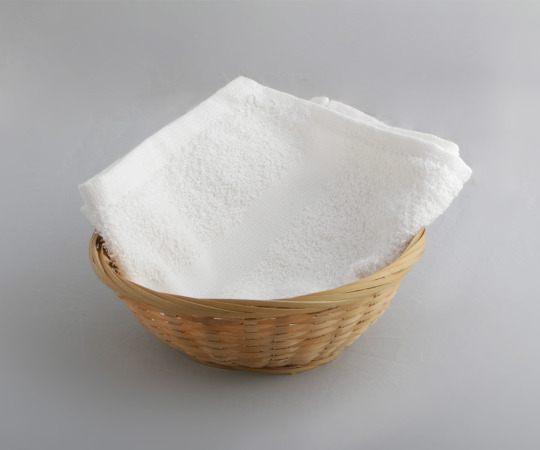
In today's environmentally conscious world, sustainability has become a top priority for businesses across all industries, including hospitality. As a result, bulk towels suppliers are increasingly focusing on eco-friendly initiatives to meet the growing demand for sustainable products in the hospitality sector.
One of the primary eco-friendly initiatives undertaken by bulk towels suppliers is the use of organic and sustainably sourced materials. Instead of traditional cotton, which requires large amounts of water and pesticides to grow, these suppliers opt for organic cotton or bamboo fibers, which are grown using sustainable farming practices and require less water and fewer chemicals. By using these materials, bulk towels suppliers can reduce their environmental impact while providing high-quality products to their customers.
Another key initiative is the adoption of environmentally friendly manufacturing processes. Many bulk towels suppliers have implemented measures to reduce water and energy consumption in their production facilities. This may include investing in energy-efficient machinery, recycling water used in the manufacturing process, and minimizing waste generation through better production planning and material utilization. These efforts not only help reduce the carbon footprint of bulk towels production but also contribute to cost savings for the suppliers.
Furthermore, bulk towels suppliers are increasingly focusing on product packaging and shipping practices to minimize their environmental impact. They may use recycled or biodegradable packaging materials and optimize shipping routes to reduce fuel consumption and emissions. Additionally, some suppliers offer bulk purchasing options or encourage customers to reuse packaging materials to further reduce waste.
In addition to these initiatives, bulk towels suppliers may also engage in partnerships with environmental organizations or participate in certification programs to demonstrate their commitment to sustainability. By obtaining certifications such as Fair Trade or Global Organic Textile Standard (GOTS), suppliers can assure customers that their products meet strict environmental and social standards.
Overall, by embracing eco-friendly initiatives, bulk towels suppliers play a crucial role in promoting sustainable hospitality practices. Through the use of organic materials, efficient manufacturing processes, and responsible packaging and shipping practices, these suppliers contribute to the preservation of the environment while meeting the needs of environmentally conscious consumers in the hospitality industry.
0 notes
Text
Elevate Your Health: The Convenience of Buying Organic Food Online
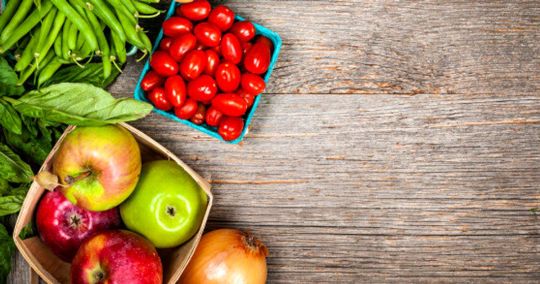
In today's fast-paced world, maintaining a healthy lifestyle can be challenging, but it's essential for overall well-being. One of the keys to a healthy diet is consuming organic food, which is free from synthetic pesticides, hormones, and genetically modified organisms (GMOs). Fortunately, with the advent of online shopping, buying organic food has never been easier or more convenient. Let's explore the benefits of purchasing organic food online and how it can contribute to a healthier lifestyle.
1. Wide Selection of Organic Products
When you buy organic food online, you have access to a vast array of organic products from various brands and suppliers. Whether you're looking for fresh fruits and vegetables, grains, dairy products, meat, poultry, or pantry staples like pasta, beans, and snacks, online retailers offer an extensive selection of organic options to suit your dietary preferences and nutritional needs. You can explore different brands, compare prices, and read product reviews to make informed choices about the organic foods you purchase.
2. Convenience and Accessibility
One of the most significant advantages of buying organic food online is the convenience it offers. With just a few clicks, you can shop for organic groceries from the comfort of your home or office, saving time and energy spent travelling to the store. Online shopping eliminates the need to navigate crowded aisles, wait in line at the checkout, or carry heavy bags of groceries. Plus, many online retailers offer flexible delivery options, including doorstep delivery or convenient pickup locations, making it easier than ever to incorporate organic foods into your diet.
3. Quality and Freshness
Contrary to popular belief, buying organic food online does not compromise quality or freshness. Online retailers prioritise the quality and freshness of their organic products, sourcing them from trusted suppliers and farms committed to organic farming practices. Many organic foods are harvested at peak ripeness and delivered directly to your doorstep, ensuring maximum flavour and nutritional value. Additionally, online retailers often provide detailed information about the sourcing and production methods of their organic products, giving you confidence in the quality and integrity of your purchases.
4. Cost-Effectiveness
Buying organic food online can also be cost-effective, especially when you consider the potential savings on transportation costs, impulse purchases, and time spent shopping in-store. Online retailers frequently offer discounts, promotions, and bulk-buying options, allowing you to stretch your food budget further and stock up on your favourite organic items at competitive prices. Additionally, online shopping enables you to compare prices across different retailers and take advantage of special offers or loyalty programs, helping you make the most economical choices for your organic grocery needs.
5. Supporting Sustainable Practices
By purchasing organic food online, you're not only investing in your health but also supporting sustainable farming practices and environmental conservation efforts. Organic farming methods prioritise soil health, biodiversity, and natural resource conservation, minimising the use of synthetic chemicals and promoting ecological balance. By choosing organic products, you're contributing to a more sustainable food system and reducing your ecological footprint. Many online retailers also prioritise sustainability by using eco-friendly packaging materials and implementing environmentally conscious shipping practices, further minimising the environmental impact of your organic food purchases.
Conclusion
In conclusion, buying organic food online offers numerous benefits, including a wide selection of organic products, convenience and accessibility, quality and freshness, cost-effectiveness, and support for sustainable practices. With the convenience of online shopping, you can easily incorporate organic foods into your diet and reap the health benefits of consuming nutritious, pesticide-free foods. Whether you're looking to stock up on pantry staples or discover new organic products, online retailers make it easier than ever to elevate your health and well-being with organic food.
0 notes